1786
Who are trilobites and how to look for them (24 photos)
Trilobites in the world no more. The last of them izdohli more than 200 million years ago, before the dinosaurs. Time of flowering and death was all Paleozoic era, which began 550 million years ago. At the beginning of her life has not come out on the land, in the end - the forests have roamed the ancestors of mammals and dinosaurs, and for all this time (especially in the early Paleozoic, in the end, they have podvymerli) trilobites were so many that the number and diversity of species, they were superior to most lived then groups of multicellular animals.
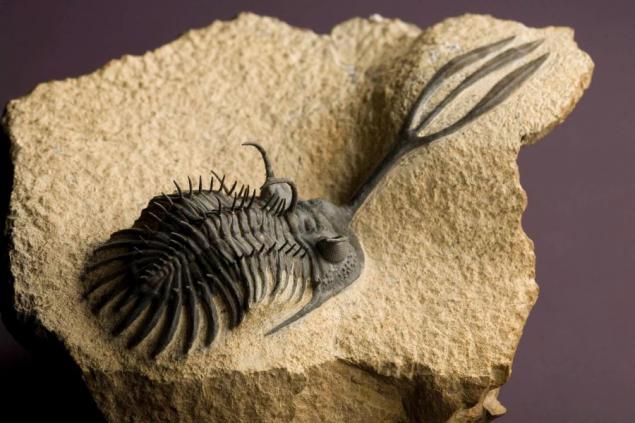
If Mesozoic era can be called the era of the dinosaurs, the Paleozoic - the era of trilobites.
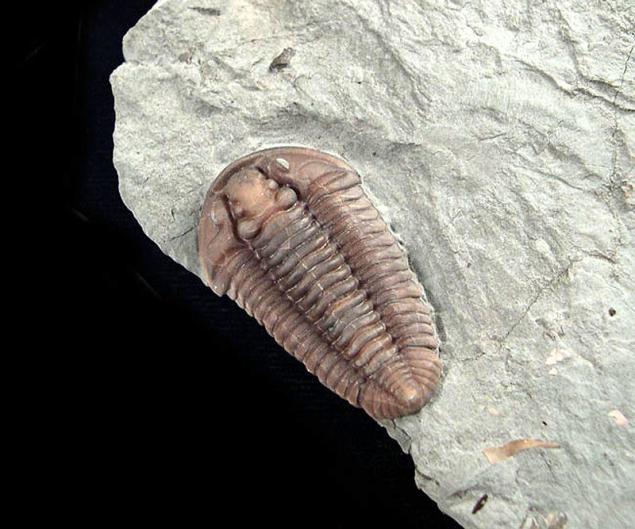
Trilobites looks like the modern woodlice - Isopoda crayfish, perhaps, to take their niche after the extinction, but it is not shellfish, and a separate class of arthropods, very primitive, some features of the structure is said to be reminiscent of polychaete worms. They even had no jaws, and the food they crushed special outgrowths three front pairs of legs.
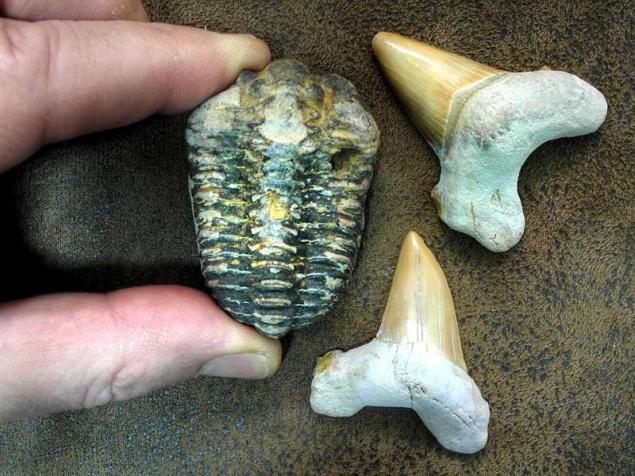
There are more than 15,000 species of trilobites from the very small, not more than a few millimeters in length, up to almost a meter. They were different: smooth, rough, spiked with enormous eyes, small and quite without eyes, with long branching outgrowths from the body, consisting of two segments or a few dozen. In the same place, without disturbing each other, might dwell with dozens of species of trilobite shells of various shapes - their diet and lifestyle differ greatly.
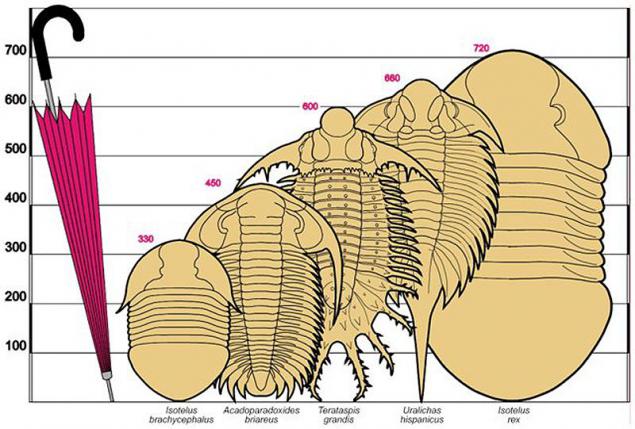
Most of them crawling along the bottom and devoured the detritus, algae and small benthos. Stomach them located at the front end of the body, between the eyes - where have decent things should settle brains. Some trilobites spent their lives entirely buried in the mud - these have eyes on stalks to poke them out:
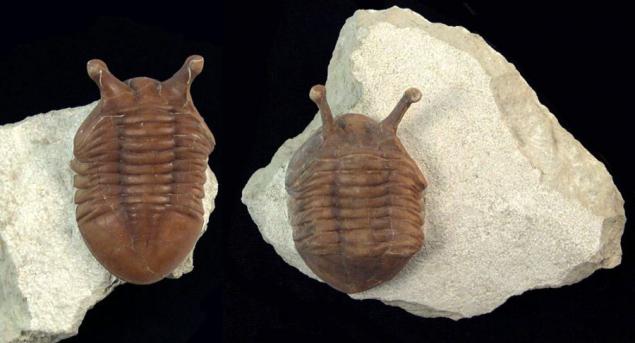
Like many marine arthropods, trilobites were in its development stage planktonic larvae, and some small planktonic trilobites were the existence of life. They have large eyes, and when minimized on the sides of the shell were large unprotected openings - exit-site swimming long limbs.
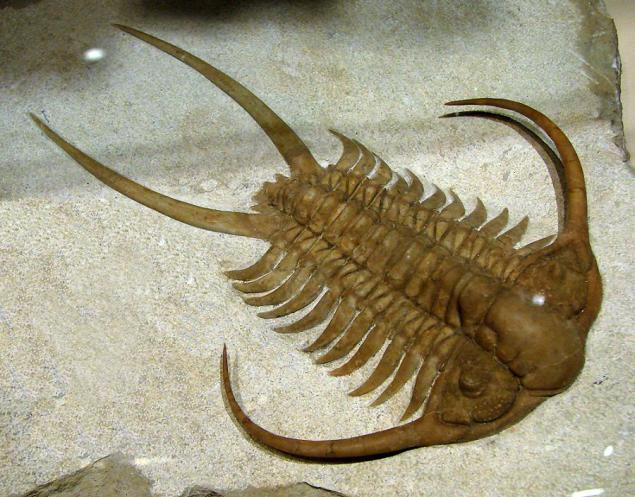
Floating trilobites got wide and flat tail shields. Such species were light armor and many processes that act as foils to float in the water column:
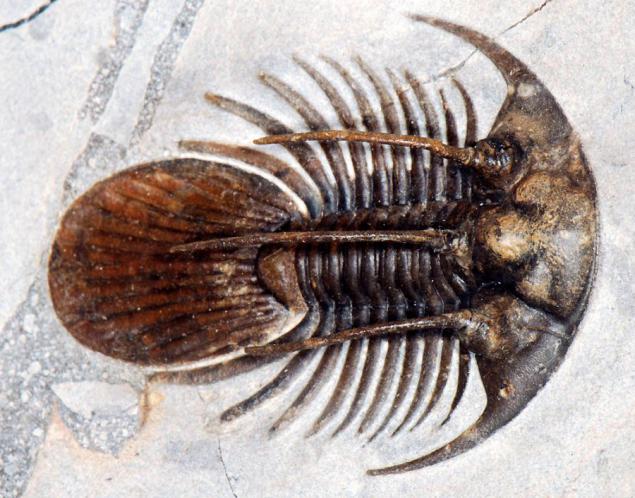
The loss of the eyes of some groups of trilobites in some cases may be associated with life in the mud or in highly turbid waters of the currents in the areas of silt accumulation in the other - the life in the darkness at great depths. For example, some small blind trilobites are considered inhabitants of great depths, are crushed due to the lack of food.
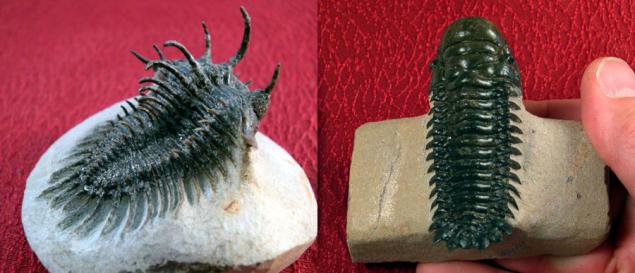
Some species of trilobites were predators - in Sweden found traces of some animals living in the soil, and the traces left by trilobites. It should trilobite trail covers the animal lived in the ground, and the breaks - trilobite ate it. In Yakutia, found trilobites with preserved bodies particles sponges and brachiopods in the gut.

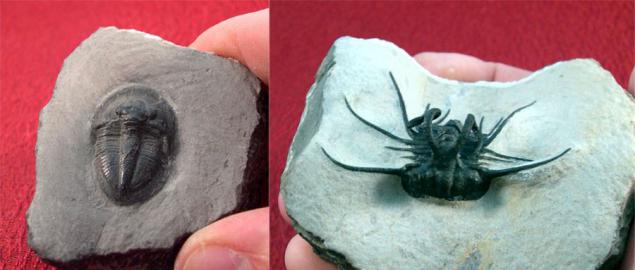
Some trilobites digestive tract in general was atrophied, and the nutrients they receive through symbiosis with bacteria chemoautotrophic living near undersea volcanic sources:
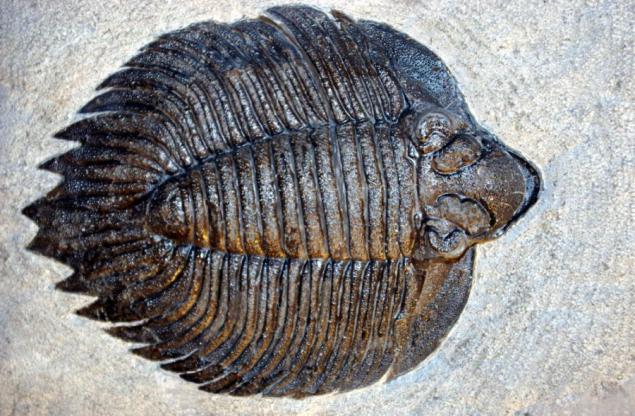
Other Trilobites were digging in the ground complex network of tunnels, which lived and - as such they were found in the Swedish limestone quarry. Details of the underground life of trilobites are still unknown. Maybe they were hiding in the tunnels from predators like the nautilus, who combed the Paleozoic oceans in search of prey. And maybe we have used the current tunnels water to oxygenate the gills, as some modern lobster.
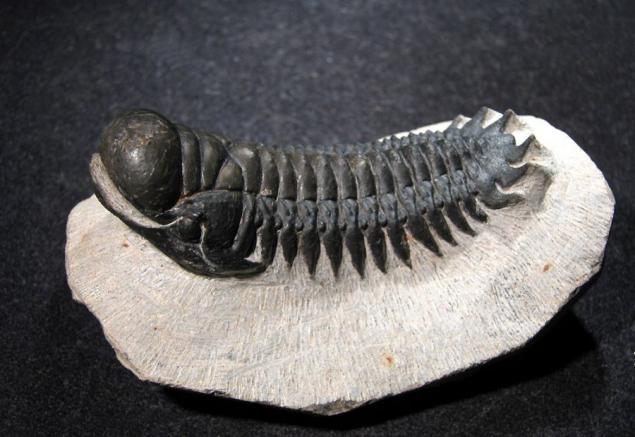
Like all arthropods, trilobites sometimes molted. The discarded exoskeletons are sometimes big heaps - apparently, trilobites, like modern crabs and lobsters, during molting gathered together to protect each other.
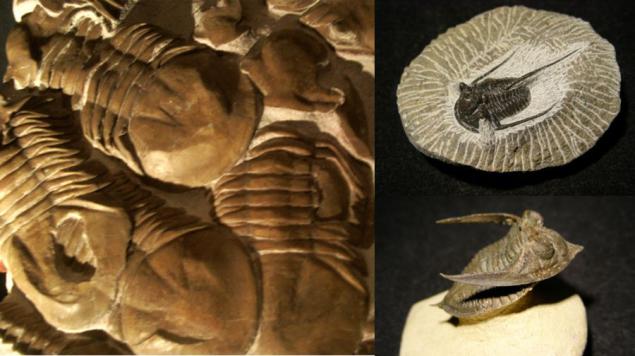
In addition, it found trilobites, which are found at the time of death, when they lined up a long chain - probably the most ancient example of a nomadic string, now common in shellfish - trilobites may also undertake seasonal migrations.
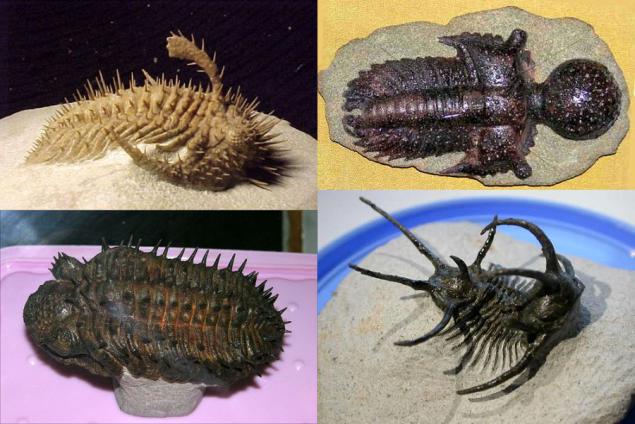
With all the diversity they all resemble each other, and saw fossilized trilobite, you can always just say that this is the trilobite, and not anything else. Their very name "trilobite" means "trilobed" - their armor consisted of three sections - a central, or axial, lateral and two flattened on both sides. That is, if across the divide, and if along - that of continuous head and tail sections and a flexible segmented thorax between them.
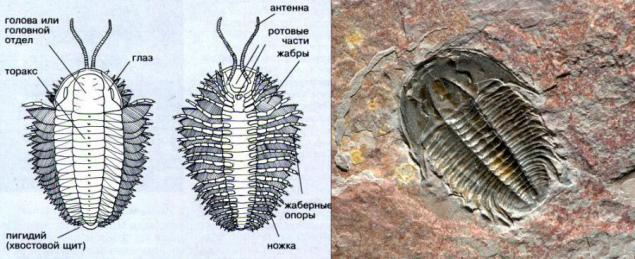
Each segment of the thorax was a pair of legs, and a head - a few, and all of them, except for a couple of antennas were arranged in the same way - each leg had a process adapted for walking (foot), breathing (Gill), for grinding and movement pischi.- particles to the mouth from back to front.
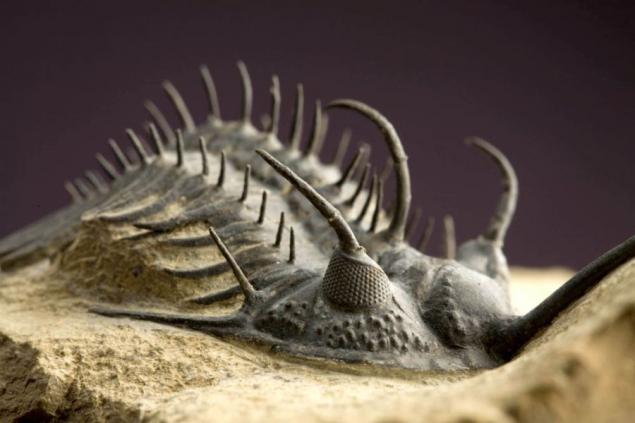
On many fossilized remains of trilobites are damaged, saying that they were hunted fish before them - cephalopods, and even earlier - different kind of strange creature Anomalocaris. To protect yourself, trilobites learned to curl up into a ball as mokritsy- "trams" Some shells grow on spikes, horns and other artful squiggles. Many trilobites were afraid of death, and in that position have been found.
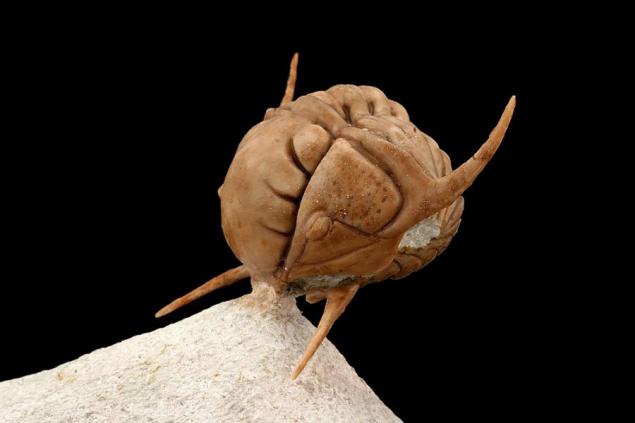
Chitin armor them still alive have been impregnated with mineral salts, making them literally stone. After the death of millions of years spent in the land, minerals, shells are usually substituted with other compounds - is a normal process for fossils. However, many compound eyes of trilobites remained unchanged, the same as in life. Particularly impressive eyes of some trilobites found in sediment formation Hamar Langdad in Morocco - they have a green color from turquoise to emerald.
This shells of trilobites are painted in a reddish-brown shades:
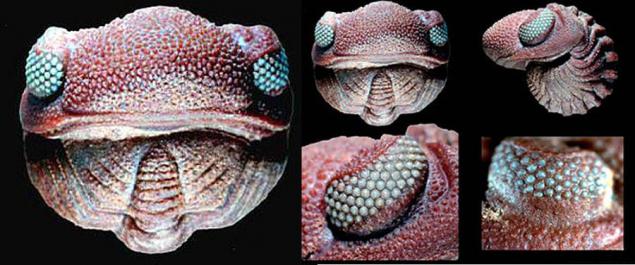
It was found that compound eyes remain lens consisting of calcite with a mixture of magnesium. A study with an electron microscope showed that part of the trilobite eye remained almost as they were during the life of these long-extinct creatures - have not undergone lens replacement, as are actually single crystals of calcite. They even kept their optical properties. Atoms are arranged in such a way that the optical crystal axis coincides with the optical axis of the lens.
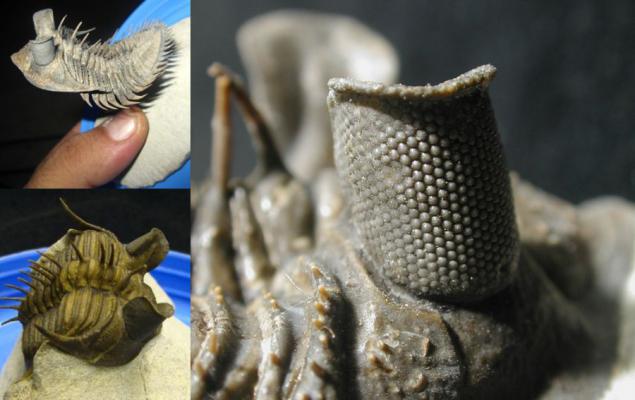
Under each calcite lens is the second, "live" - from chitin. The refractive indices of calcite and chitin are aligned with each other so that each facet of the trilobite is essentially a classic achromatic doublet - used in modern optics bilayer lens that prevents light scattering of different wavelengths - unlike ommatidia modern insects and crustaceans are a single-lens "monocles" * - the ability to "Focusing" the eyes of trilobites, like insects, did not have, but that it was not necessary: the objects at a distance of a few centimeters to several meters or have them in focus simultaneously. Pieces smaller than facets, however, trilobites still did not distinguish, but it they were not necessary. But the magic crystal eyes were almost not susceptible to damage.
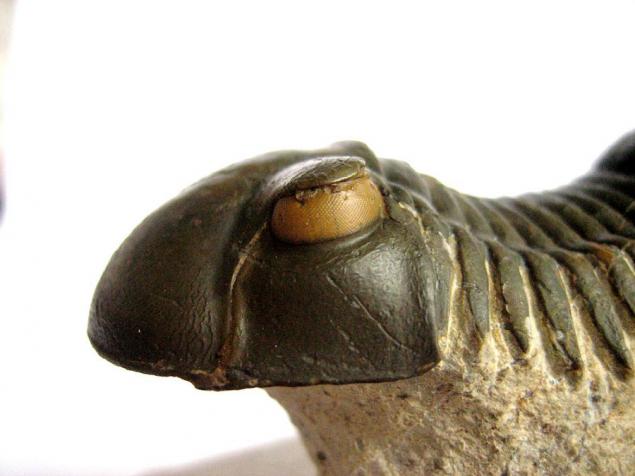
So it goes. What were trilobites in the dynamics - not be able to show, instead, to those who know how to look at a stereo pair - 3D-trilobites:
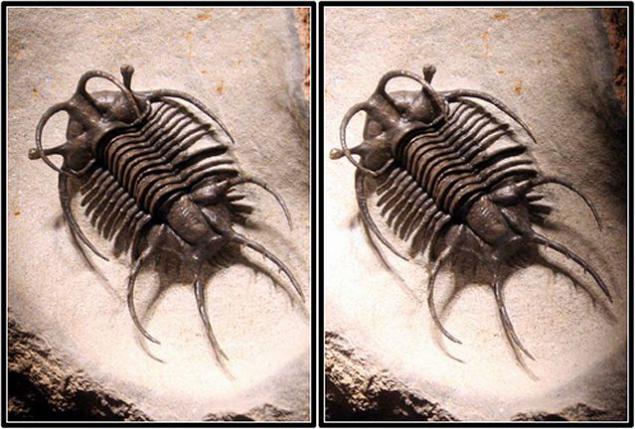
What first attracted the attention of visitors to the Museum of Paleontology? The skeletons of dinosaurs and mammoths! Smaller exhibits: fossilized seashells, sponges, corals, fish, leaf imprints, and sometimes whole trunks of ancient plants, even in the age of hundreds of millions of years - seem to most of us, inexperienced in science, familiar. We often indifferent slide of his eyes: that we now can see the sea almost the same shell. However, being oval on stone tiles, often with the size of a matchbox, forced to stop. They its appearance like no one familiar animals, and at the same time, some of their bodies are easily recognizable and have counterparts.
Different species of trilobites, belonging to dozens of families and groups, have mastered various ecological niches. Most of them had to crawl on the bottom of the mud-eaters, but there were also free-swimming species, even predators.
The variety in the monotony
It is because of this property fossilized trilobites proved popular collectible objects. And not only serious collecting. Stone "Scout" on my shelf with pleasure and put a man far removed from paleontology.
The fact that demand for trilobites high enough, it is easy to make mineralogical fairs, although prices are rather big. Most often exhibit and sell trilobites from Morocco. These coal-black, some are very beautiful, especially green and red stalk-eyes (of course, this is not the lifetime colors, and acquired in the process of mineralization).
There are at exhibitions and trilobites found in the territory of Russia. They are yellowish-brown, belong to the Ordovician (450-490 million years ago). Visitors to exhibitions, tend to think that these fossils are extremely rare and to discover them yourself easily. In fact, to find a trilobite can practically everyone in the European part of the country, especially in the North-West Federal District.
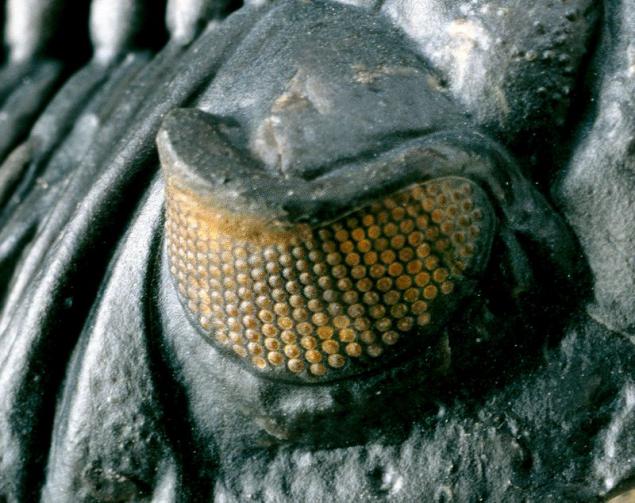
Here are some tips
Moving from St. Petersburg for Murmansk highway, fifty kilometers from the city, from the window of the car can be seen on the right, to the south, a sharp shoulder height of about one hundred meters, which stretches parallel to the road a few kilometers from it. Its length - more than a hundred kilometers. Geologists call this education Glint. After rising to the glint in any place, you find yourself on a plateau, folded limestone in fact petrified silt that is deposited on the seabed nearly half a billion years ago - in the heyday of trilobites. At the bottom of rivers and gullies cut through the array, fossilized remains of ancient marine life across very often, but as a rule, "peretёrtom" form.
Well-preserved fossils look better in his career - the Ordovician limestones has long developed on limestone and schebёnku. Administration of the pits is not usually against amateur collection of fossils, but the resolution, say a mountain wizard should still ask. One of the quarries located near the village Putilovo. The piles of rubble and blocks of limestone at its bottom across all sorts of shells of brachiopods, "shaybochki" sea lilies, a little less - like spear-shell cephalopods tsilindrotserasov up to one meter. It is not easy to find and trilobites, but usually in the form of fragments, at best - if discarded molt shells without head shields. After the fossils so easily arranged organisms (shell composed of individual plates) can easily break and collapse - is much easier than the host rock! To get a more or less a copy has to beat the stones with a hammer. The hardness of limestone varies in different layers, and the number of trilobites them unequal.
Best of all trilobites are preserved in clay, water-saturated layer at the top of the quarry, for some reason called the collectors "Gorelik." Rising to curb career, you see the punched holes in the stone, and near them - piles of crushed stone. The scale of it is comparable to the work of excavating the bottom of the pit! All this - traces of gatherer-merchants. Often found themselves smashing hammers chunks of productive layer. These people are usually interesting, sincere and loving paleontology beginners ready to explain what's what. You can find the quarries Ordovician Plateau and students of geological and geographical faculty, passing here every summer the usual field practice.
I do not advise to stop only at the top of the quarry. Firstly, in its development (expansion) pieces of "Gorelik" in the set are at the bottom, and secondly, in the lower layers often get more rare than the typical top of the representatives of the genus of trilobites Asaphus.
Good trilobite specimens caught in the Devonian sediments characteristic of Pskov and Novgorod regions, and even in suburban limestones of Carboniferous period (Carboniferous). However, in this period, the era of trilobites already came to an end, and even in the most ancient sediments of the Lower Carboniferous, such as in the Kaluga region, the trilobites are rare and usually only dropped during molt backs shells. The number of known species can be counted on the fingers, and almost all of them small - 2-3 cm long, are found usually next to the "bushes" fossilized coral-siringopor. Perhaps in these trilobites they were hiding from predators.
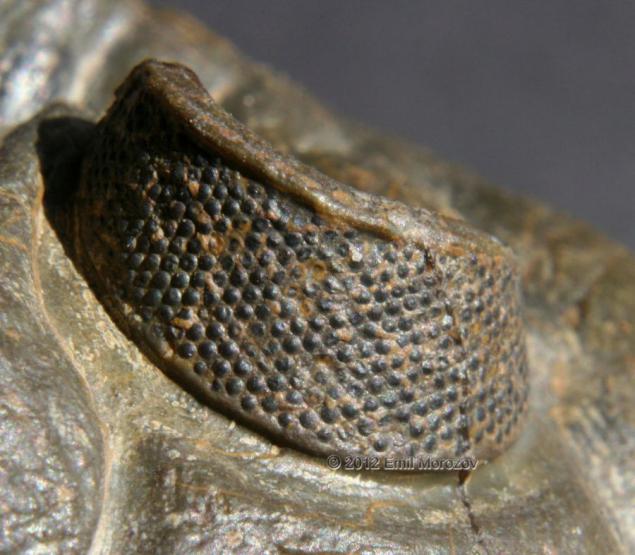
Odontochile hausmanni, completely authentic trilobite from Morocco, Paleozoic.
Skill and flair
The fossil is always better to take a piece of the host rock, reducing to a reasonable hammer weight / safety. The more rare species is found, the larger the stone should be left. And not just because of fear of destroying the find. Even an experienced collector of which revealed a small fragment is not always clear, as is the trilobite in a stone: because it can be bent, rolled ball. Splinter fragments immediately pasted cyanoacrylate glue. Finally dissected specimens home, at the table. Use tools such as core or narrow zubiltse best as helpers - a scalpel and a sharp needle (fit all kinds of drawing instruments compasses legs, if it is convenient to attach to the handle).
Unfortunately, to teach the art of dissection paleontological specimens by correspondence is almost impossible - experience is important here. The most common rule: to direct the tool to spearhead the fossil (not from her) and try not to scratch them breed, and squeeze. Rare samples (spiked, horned, etc.) it is best to trust the people experienced. When dissection killed so many unique pieces, and comfort that they still would get in the original mill, to help the weak.
But no matter how we tried, vyboinki, the loss of individual fragments are inevitable. Simulates fossilized chitin thick mixture of epoxy resin powder sifted Ordovician limestone. It is only necessary to choose the color, but for this to take several stones of different colors. Those magnificent trilobites, which are sold at fairs, often largely composed of a mastic, and among Moroccan there are real fake, fashioned entirely out of clay.
The prepared fossil can be very carefully covered with a thin layer of colorless tsaponlaka - it will improve the appearance and, most importantly, strengthen the chitin on fragile samples.
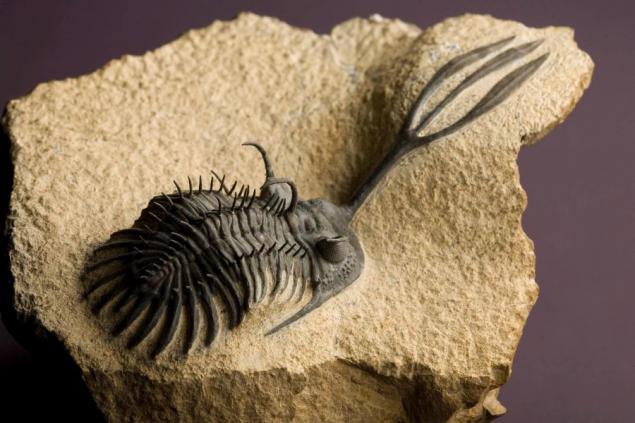
About living trilobites
As already mentioned, the trilobites became extinct more than 200 million years ago. The only remotely similar to these animals now living - horseshoe crabs. They also appeared in the Ordovician period, but, unlike the trilobites, five of their species survived to the present day. Inhabit these "living fossils" in several areas of the oceans and how their way of life, and in many parts of anatomy (compound eyes, dorsal shell, a method of transferring) similar to trilobites. But although they are descended from a common ancestor, horseshoe crabs are quite another class of arthropods. Perhaps somewhere on the ocean floor and hidden past of the tribe of trilobites. Finding them would be a sensation, with more than living dinosaur discovery, whose epoch separated from our "only" 60 million years.
And such "sensations" in recent years, often happen! And the trilobites are not in the ocean depths, and in the most populated parts of Russia.
So, back in 2007 creature unknown to science have been discovered in one of the abandoned pits in Chelyabinsk. Around the same time, these same creatures the size of a palm seems to be seen somewhere in the suburbs. And last year, it was reported trilobites caught in some kind of pond and brought to Almaty Zoo.
In fact, in many parts of Russia are "trilobites" teeming with summer almost every puddle. In my native place, in the west of the Kaluga region, the villagers called them "Opolovnikov" and not considered unusual creatures. And zoologists even two hundred years ago, these animals are described and studied. They are called Szczytno and belong to the crustaceans. Simply put - it's crustaceans, but not crawling, and floating, like known to all aquarists Daphnia and Cyclops, only bigger - there are up to 8 cm wide.

If Mesozoic era can be called the era of the dinosaurs, the Paleozoic - the era of trilobites.

Trilobites looks like the modern woodlice - Isopoda crayfish, perhaps, to take their niche after the extinction, but it is not shellfish, and a separate class of arthropods, very primitive, some features of the structure is said to be reminiscent of polychaete worms. They even had no jaws, and the food they crushed special outgrowths three front pairs of legs.

There are more than 15,000 species of trilobites from the very small, not more than a few millimeters in length, up to almost a meter. They were different: smooth, rough, spiked with enormous eyes, small and quite without eyes, with long branching outgrowths from the body, consisting of two segments or a few dozen. In the same place, without disturbing each other, might dwell with dozens of species of trilobite shells of various shapes - their diet and lifestyle differ greatly.

Most of them crawling along the bottom and devoured the detritus, algae and small benthos. Stomach them located at the front end of the body, between the eyes - where have decent things should settle brains. Some trilobites spent their lives entirely buried in the mud - these have eyes on stalks to poke them out:

Like many marine arthropods, trilobites were in its development stage planktonic larvae, and some small planktonic trilobites were the existence of life. They have large eyes, and when minimized on the sides of the shell were large unprotected openings - exit-site swimming long limbs.

Floating trilobites got wide and flat tail shields. Such species were light armor and many processes that act as foils to float in the water column:

The loss of the eyes of some groups of trilobites in some cases may be associated with life in the mud or in highly turbid waters of the currents in the areas of silt accumulation in the other - the life in the darkness at great depths. For example, some small blind trilobites are considered inhabitants of great depths, are crushed due to the lack of food.

Some species of trilobites were predators - in Sweden found traces of some animals living in the soil, and the traces left by trilobites. It should trilobite trail covers the animal lived in the ground, and the breaks - trilobite ate it. In Yakutia, found trilobites with preserved bodies particles sponges and brachiopods in the gut.


Some trilobites digestive tract in general was atrophied, and the nutrients they receive through symbiosis with bacteria chemoautotrophic living near undersea volcanic sources:

Other Trilobites were digging in the ground complex network of tunnels, which lived and - as such they were found in the Swedish limestone quarry. Details of the underground life of trilobites are still unknown. Maybe they were hiding in the tunnels from predators like the nautilus, who combed the Paleozoic oceans in search of prey. And maybe we have used the current tunnels water to oxygenate the gills, as some modern lobster.

Like all arthropods, trilobites sometimes molted. The discarded exoskeletons are sometimes big heaps - apparently, trilobites, like modern crabs and lobsters, during molting gathered together to protect each other.

In addition, it found trilobites, which are found at the time of death, when they lined up a long chain - probably the most ancient example of a nomadic string, now common in shellfish - trilobites may also undertake seasonal migrations.

With all the diversity they all resemble each other, and saw fossilized trilobite, you can always just say that this is the trilobite, and not anything else. Their very name "trilobite" means "trilobed" - their armor consisted of three sections - a central, or axial, lateral and two flattened on both sides. That is, if across the divide, and if along - that of continuous head and tail sections and a flexible segmented thorax between them.

Each segment of the thorax was a pair of legs, and a head - a few, and all of them, except for a couple of antennas were arranged in the same way - each leg had a process adapted for walking (foot), breathing (Gill), for grinding and movement pischi.- particles to the mouth from back to front.

On many fossilized remains of trilobites are damaged, saying that they were hunted fish before them - cephalopods, and even earlier - different kind of strange creature Anomalocaris. To protect yourself, trilobites learned to curl up into a ball as mokritsy- "trams" Some shells grow on spikes, horns and other artful squiggles. Many trilobites were afraid of death, and in that position have been found.

Chitin armor them still alive have been impregnated with mineral salts, making them literally stone. After the death of millions of years spent in the land, minerals, shells are usually substituted with other compounds - is a normal process for fossils. However, many compound eyes of trilobites remained unchanged, the same as in life. Particularly impressive eyes of some trilobites found in sediment formation Hamar Langdad in Morocco - they have a green color from turquoise to emerald.
This shells of trilobites are painted in a reddish-brown shades:

It was found that compound eyes remain lens consisting of calcite with a mixture of magnesium. A study with an electron microscope showed that part of the trilobite eye remained almost as they were during the life of these long-extinct creatures - have not undergone lens replacement, as are actually single crystals of calcite. They even kept their optical properties. Atoms are arranged in such a way that the optical crystal axis coincides with the optical axis of the lens.

Under each calcite lens is the second, "live" - from chitin. The refractive indices of calcite and chitin are aligned with each other so that each facet of the trilobite is essentially a classic achromatic doublet - used in modern optics bilayer lens that prevents light scattering of different wavelengths - unlike ommatidia modern insects and crustaceans are a single-lens "monocles" * - the ability to "Focusing" the eyes of trilobites, like insects, did not have, but that it was not necessary: the objects at a distance of a few centimeters to several meters or have them in focus simultaneously. Pieces smaller than facets, however, trilobites still did not distinguish, but it they were not necessary. But the magic crystal eyes were almost not susceptible to damage.

So it goes. What were trilobites in the dynamics - not be able to show, instead, to those who know how to look at a stereo pair - 3D-trilobites:

What first attracted the attention of visitors to the Museum of Paleontology? The skeletons of dinosaurs and mammoths! Smaller exhibits: fossilized seashells, sponges, corals, fish, leaf imprints, and sometimes whole trunks of ancient plants, even in the age of hundreds of millions of years - seem to most of us, inexperienced in science, familiar. We often indifferent slide of his eyes: that we now can see the sea almost the same shell. However, being oval on stone tiles, often with the size of a matchbox, forced to stop. They its appearance like no one familiar animals, and at the same time, some of their bodies are easily recognizable and have counterparts.
Different species of trilobites, belonging to dozens of families and groups, have mastered various ecological niches. Most of them had to crawl on the bottom of the mud-eaters, but there were also free-swimming species, even predators.
The variety in the monotony
It is because of this property fossilized trilobites proved popular collectible objects. And not only serious collecting. Stone "Scout" on my shelf with pleasure and put a man far removed from paleontology.
The fact that demand for trilobites high enough, it is easy to make mineralogical fairs, although prices are rather big. Most often exhibit and sell trilobites from Morocco. These coal-black, some are very beautiful, especially green and red stalk-eyes (of course, this is not the lifetime colors, and acquired in the process of mineralization).
There are at exhibitions and trilobites found in the territory of Russia. They are yellowish-brown, belong to the Ordovician (450-490 million years ago). Visitors to exhibitions, tend to think that these fossils are extremely rare and to discover them yourself easily. In fact, to find a trilobite can practically everyone in the European part of the country, especially in the North-West Federal District.

Here are some tips
Moving from St. Petersburg for Murmansk highway, fifty kilometers from the city, from the window of the car can be seen on the right, to the south, a sharp shoulder height of about one hundred meters, which stretches parallel to the road a few kilometers from it. Its length - more than a hundred kilometers. Geologists call this education Glint. After rising to the glint in any place, you find yourself on a plateau, folded limestone in fact petrified silt that is deposited on the seabed nearly half a billion years ago - in the heyday of trilobites. At the bottom of rivers and gullies cut through the array, fossilized remains of ancient marine life across very often, but as a rule, "peretёrtom" form.
Well-preserved fossils look better in his career - the Ordovician limestones has long developed on limestone and schebёnku. Administration of the pits is not usually against amateur collection of fossils, but the resolution, say a mountain wizard should still ask. One of the quarries located near the village Putilovo. The piles of rubble and blocks of limestone at its bottom across all sorts of shells of brachiopods, "shaybochki" sea lilies, a little less - like spear-shell cephalopods tsilindrotserasov up to one meter. It is not easy to find and trilobites, but usually in the form of fragments, at best - if discarded molt shells without head shields. After the fossils so easily arranged organisms (shell composed of individual plates) can easily break and collapse - is much easier than the host rock! To get a more or less a copy has to beat the stones with a hammer. The hardness of limestone varies in different layers, and the number of trilobites them unequal.
Best of all trilobites are preserved in clay, water-saturated layer at the top of the quarry, for some reason called the collectors "Gorelik." Rising to curb career, you see the punched holes in the stone, and near them - piles of crushed stone. The scale of it is comparable to the work of excavating the bottom of the pit! All this - traces of gatherer-merchants. Often found themselves smashing hammers chunks of productive layer. These people are usually interesting, sincere and loving paleontology beginners ready to explain what's what. You can find the quarries Ordovician Plateau and students of geological and geographical faculty, passing here every summer the usual field practice.
I do not advise to stop only at the top of the quarry. Firstly, in its development (expansion) pieces of "Gorelik" in the set are at the bottom, and secondly, in the lower layers often get more rare than the typical top of the representatives of the genus of trilobites Asaphus.
Good trilobite specimens caught in the Devonian sediments characteristic of Pskov and Novgorod regions, and even in suburban limestones of Carboniferous period (Carboniferous). However, in this period, the era of trilobites already came to an end, and even in the most ancient sediments of the Lower Carboniferous, such as in the Kaluga region, the trilobites are rare and usually only dropped during molt backs shells. The number of known species can be counted on the fingers, and almost all of them small - 2-3 cm long, are found usually next to the "bushes" fossilized coral-siringopor. Perhaps in these trilobites they were hiding from predators.

Odontochile hausmanni, completely authentic trilobite from Morocco, Paleozoic.
Skill and flair
The fossil is always better to take a piece of the host rock, reducing to a reasonable hammer weight / safety. The more rare species is found, the larger the stone should be left. And not just because of fear of destroying the find. Even an experienced collector of which revealed a small fragment is not always clear, as is the trilobite in a stone: because it can be bent, rolled ball. Splinter fragments immediately pasted cyanoacrylate glue. Finally dissected specimens home, at the table. Use tools such as core or narrow zubiltse best as helpers - a scalpel and a sharp needle (fit all kinds of drawing instruments compasses legs, if it is convenient to attach to the handle).
Unfortunately, to teach the art of dissection paleontological specimens by correspondence is almost impossible - experience is important here. The most common rule: to direct the tool to spearhead the fossil (not from her) and try not to scratch them breed, and squeeze. Rare samples (spiked, horned, etc.) it is best to trust the people experienced. When dissection killed so many unique pieces, and comfort that they still would get in the original mill, to help the weak.
But no matter how we tried, vyboinki, the loss of individual fragments are inevitable. Simulates fossilized chitin thick mixture of epoxy resin powder sifted Ordovician limestone. It is only necessary to choose the color, but for this to take several stones of different colors. Those magnificent trilobites, which are sold at fairs, often largely composed of a mastic, and among Moroccan there are real fake, fashioned entirely out of clay.
The prepared fossil can be very carefully covered with a thin layer of colorless tsaponlaka - it will improve the appearance and, most importantly, strengthen the chitin on fragile samples.

About living trilobites
As already mentioned, the trilobites became extinct more than 200 million years ago. The only remotely similar to these animals now living - horseshoe crabs. They also appeared in the Ordovician period, but, unlike the trilobites, five of their species survived to the present day. Inhabit these "living fossils" in several areas of the oceans and how their way of life, and in many parts of anatomy (compound eyes, dorsal shell, a method of transferring) similar to trilobites. But although they are descended from a common ancestor, horseshoe crabs are quite another class of arthropods. Perhaps somewhere on the ocean floor and hidden past of the tribe of trilobites. Finding them would be a sensation, with more than living dinosaur discovery, whose epoch separated from our "only" 60 million years.
And such "sensations" in recent years, often happen! And the trilobites are not in the ocean depths, and in the most populated parts of Russia.
So, back in 2007 creature unknown to science have been discovered in one of the abandoned pits in Chelyabinsk. Around the same time, these same creatures the size of a palm seems to be seen somewhere in the suburbs. And last year, it was reported trilobites caught in some kind of pond and brought to Almaty Zoo.
In fact, in many parts of Russia are "trilobites" teeming with summer almost every puddle. In my native place, in the west of the Kaluga region, the villagers called them "Opolovnikov" and not considered unusual creatures. And zoologists even two hundred years ago, these animals are described and studied. They are called Szczytno and belong to the crustaceans. Simply put - it's crustaceans, but not crawling, and floating, like known to all aquarists Daphnia and Cyclops, only bigger - there are up to 8 cm wide.























